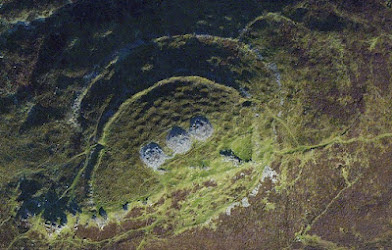If anybody ever accuses me of being pathologically opposed to the idea of any prehistoric stone quarrying, I shall get very angry, and will point out that there are some perfectly splendid prehistoric stone quarries on the flank of Foel Drygarn, beneath the crags at the western end of the hill-fort. The one beneath the westernmost crag is the biggest. I have drawn attention to these on several occasions, and I am mystified that archaeologists hardly ever refer to them. Article after article about Preseli and the bluestones, one book chapter after another, and no mentions. Why on earth is that? After all, the evidence is very good, and stands up well under scrutiny:
https://brian-mountainman.blogspot.com/2018/10/the-prehistoric-quarries-at-foel-drygarn.html
https://brian-mountainman.blogspot.com/2022/03/foel-drygarn-prehistoric-quarrying.html
The quarries have been used for the extraction of "bluestones" -- mostly rhyolite and felspathic tuffs, but the geology is quite complex.
Perhaps there are real problems for the archaeology establishment:
1. The quarries are almost certainly Bronze Age and Iron Age -- too late for the convenience of the Stonehenge researchers. They desperately need NEOLITHIC quarries.
2. The quarrymen were taking small slabs of rock, mostly of a size that could be carried by one man, for use in the Bronze Age burial mounds on the summit, and maybe also for the Iron Age defensive walls.
3. None of the local rhyolites of other rocks at Stonehenge have been definitively sourced to Foel Drygarn, therefore rendering this site (Foel Drygarn) largely irrelevant. (In fact I think it's hugely important.......)
4. Because the Stonehenge researchers are obsessed with monoliths or orthostats, this site is really of no interest to them.
5. The stones on the burial mounds, and those left behind on the scree slopes that have been quarried are almost all sharp-edged and sub-angular in shape. That is what you would expect of material quarried from scree slopes. (Note that the so-called "quarried" bluestone monoliths at Stonehenge are not this shape at all.....)
For me the significance of the quarries lies in the fact that the stones taken were small, locally derived and used within a couple of hundred metres of the quarries. There was economy of effort, and no sign that large monoliths were taken, even for local use. These utilitarian rules applied, even though sacred structures (large burial mounds) were being built. As for the techniques, I can see no sign here of levers, wedges, platforms, fulcrums or anything else being used -- the quarrymen (and there must have been many of them) were simply collecting broken slabs of scree, at the foot of the spectacular crags that still dominate the landscape. The larger stones from the rockfalls were simply left behind.
So there we are then -- a post from me in praise of bluestone quarries........
But please don't expect me to sing the praises of the "quarries" at Carn Goedog, Rhosyfelin or Carn Ddu-bach (the latest to be added to the list). At those sites, which I have examined carefully, the evidence simply does not withstand scrutiny, having been invented in the course of an extended exercise in ruling hypothesis confirmation by MPP and his co-workers.


No comments:
Post a Comment